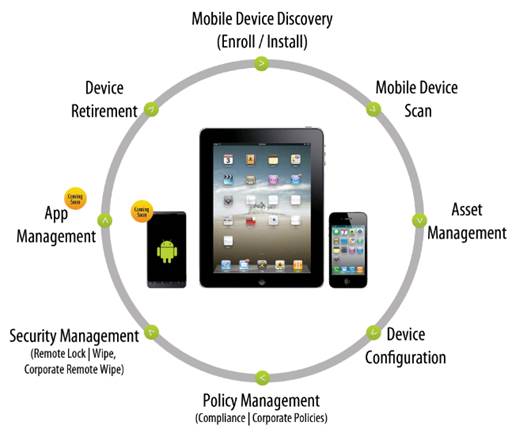Balance worker productivity &
data concerns
As Brad S., Current Analysis
(www.currentanalvsis.com) principal analyst, says, having data that travels
with you is "an integral component of the modern workforce." Increasingly
this means modern employees want to work as efficiently and easily as possible
using the devices they want, accessing data wherever they are, and
collaborating and sharing with others as needed. This includes using Web-based
collaboration and sharing services. For companies, however, the productivity
that such services provide workers typically means relinquishing at least
some control over company data. The following explores how businesses can go
about enabling online collaboration and sharing without losing excessive
control of their data.

How
businesses can go about enabling online collaboration and sharing without
losing excessive control of their data
The “personalization” of it
Users' reliance on mobile devices has
significantly altered how IT must manage and control company data. The trend is
often referred to as "the consumerization of IT," but Cheryl
McKinnon, Candy Strategies (www.candvstrategies.com) president, says a better
term is "personalization of IT." In the context of technology and
data, she says, "consumer" elicits the notion of "receiving
without contributing," which is the opposite of what the trend
represents.
"Ultimately, what we're seeing is the
increasing level of technical comfort and savvy among regular business
users," McKinnon says. "Tech, digital photography, apps, Web, mobile,
Web content, or blogging platforms are no longer the domain of the geek but of
nearly everyone." As such, information workers are growing increasingly
impatient "wondering why they need to settle for clunky, outdated, unintuitive
systems and interfaces when things are so much easier at home," she says.
Christian Kane, Forrester Research
(www.forrester.com) analyst, says that in the past an employee's first smartphone
or computer was oftentimes a company-issued device; therefore the company
essentially dictated the initial experience and expectations. Now, consumer
products set expectations far more often than the company does. Further, Kane
says, IT has essentially become a competitor in contrast to consumer channels,
so IT must start thinking about how it delivers services, the quality of
service it provides, and what the user experience is like. "IT basically
can't dictate what a user installs in a BYOD scenario, so they now have to
focus a lot more on how they deal with data and applications," he says.
How aware are you?
In terms of consumer Web-based
collaboration and file sharing services, companies are generally aware of the
risks involved with employees uploading and sharing company data online.
Companies experienced a similar situation previously in terms of employees
using floppy diskettes, thumb drives, and other portable media to transfer
company data, Shimmin says. What companies may not realize is how widespread
the adoption of cloud-based storage and sharing services has become and how
many services there are, he says.
McKinnon says although IT or records
management departments may possess a bit of denial about the pervasiveness of
consumer device usage among employees, the degree of risk can vary
dramatically among organizations depending on the content workers are
uploading/ sharing. Overall, Kane says, cloud-based storage services pose a
huge challenge to companies because they target consumers and offer business benefits
yet provide companies with no insight into or control over the data stored
there.
Shimmin compares the situation to employee
use of instant messaging apps years ago. IT found itself needing to adopt an
internal solution that either blocked such traffic or managed, governed, and
secured it. Ultimately, the latter solution won out. "I think we'll see
that exact same sort of trajectory with file sharing, which companies may
initially decide to block such traffic to ensure there aren't any issues, particularly
if they're in a sensitive industry," Shimmin says. Ultimately, though,
Shimmin believes governance and management solutions, including MDM (mobile
device management) solutions "strictly aimed at taking care of this
problem" will win out.

Mobile
Device Management
Allowance with control
Where online collaboration is concerned,
there is a growing number of alternatives to consumer options that enhance
worker productivity but help prevent excessive loss of company data. Such
solutions provide controls to disable downloads, securely share data outside
the company realm, and perform auditing, Kane says.
Ultimately, McKinnon says, a company's
mentality toward collaboration/sharing should be to ensure that IT is serving
the needs of frontline business workers. "If workers are self-provisioning
their own cloud, Web, or mobile apps for file sharing and collaboration,
clearly there's a gap in what their in-house IT teams have provided," she
says.
"Tools may be too complex, too
expensive, hard to use with external parties, or simply not well promoted or
advertised internally," McKinnon says. Fortunately, a rich set of options
has emerged in recent years with a bigger range of tools suitable for all types
of budgets and platforms, she adds.
Weigh the options
Exactly how companies should go about
enabling online collaboration and sharing can vary. One option is creating and
managing accounts for employees. This might be feasible for smaller companies
handling low-sensitivity data, McKinnon says, but likely more problematic for
larger enterprises due to consistency and the need to establish guidelines for
securing, deleting, and sharing content. "Scattered repositories of
content can present risk when employees leave, passwords are forgotten, and
information can't be found or trusted to be accurate," she says. Risks
potentially can turn into lawsuits, audits, fines, and sanctions.
Another option is acquiring a content
management solution with built-in collaboration and sharing features. McKinnon
says most organizations should at least investigate this option. "There's
a much broader range of tools on the market today to address all levels of
budget and need including free, 'freemium,' open-source, and SaaS," she
says. "Getting input from the frontline workers on how they need to share
information, with whom, and why will be useful when developing the requirements
to meet common use cases." Kane concurs on this last point; he says,
"The most important piece here is understanding what the employees'
requirements are."
Solutions available include intuitive,
enterprise-aimed SaaS (software as a service, or cloud software) models, which
are gaining strong market momentum, McKinnon says. Other possibilities include
open-source alternatives suitable for companies that prefer on-premises
Web-based file sharing. Elsewhere, larger, long-established content-management
vendors are augmenting their product suites, she says.
Beyond file syncing and sharing, a good
solution should enable employees to create and manage team libraries and
individual accounts and share with customers and others outside the company.
Important abilities for IT and management include download control, auditing,
mobile and Web UIs, offline document support, security settings to restrict access,
and tag and search support.
SLAs, McKinnon says, should outline what
happens to deleted documents, how documents can be downloaded upon contract
termination, uptime and availability parameters, and timelines concerning bug
fixes. Regulated industries might require commitments on data sovereignty,
adherence to security standards, identity management, and procedures to
request data deemed discoverable in cases of litigation or audits.
User guidelines
Whatever path companies take, outlining
employee expectations regarding usage of services and company data is
advisable. Guidelines should make clear the types of content subject to
security, privacy, and other regulations, McKinnon says, as well as detail how
data must be protected. "What can be shared, with whom, and where [these]
are important to outline and may vary from department to department," she
says. "The risk is likely low for a graphic designer when sharing a
brochure mock-up with a marketing agency but can be high when corporate legal
counsel is sharing contracts with their external law firm." IT and compliance
teams, meanwhile, should define data that is confidential and subject to
regulations or other non-disclosure policies.
Kane says while effective guidelines are a
great starting place, "where there's a will there's a way." Companies
should focus on keeping data secure and motivating employees to use tools
correctly. "The best motivators are experience, ease of use, and of course
something that meets their needs," he says. "Again, employees aren't
breaking guidelines just to break them; they're doing it to get their jobs
done. If your top sales performer every quarter uses all her own technology,
the business leaders aren't going to tell that person to stop," he says.
"This is why we see an increasing number of companies looking to
understand why employees use the tools they do and deliver around those
needs."
Key points
Web-based collaboration and file-sharing
services generally result in more productive workers but less company control
of data.
Many businesses are aware of associated
risks but not necessarily how many online collaboration and sharing services
there are and how pervasive usage is.
Content management (including mobile device
management) solutions are increasingly including collaboration and
file-sharing tools.
Companies should set clear and effective
guidelines concerning usage of online collaboration and sharing services and
what company data can be shared, with whom, and how.